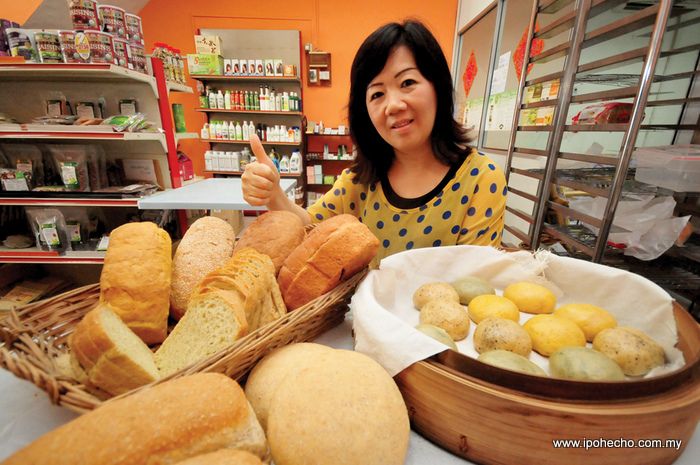





I have never been big on bread. On the occasion when I’m in a restaurant and I’m served a piping hot roll or basket of bread, I may have a bite or two, more for the butter which I slather on, than for the bread itself. If I eat too much bread as in the occasional sandwich, I feel myself bloated and in general malaise.
I do love bread though – not the soft pap that passed as bread in my childhood and the commercial variety that is ubiquitous in restaurants and street corners these days but bread with bite: dark or light, crunchy, nutty, seedy, chewy with a hard crust and a depth of flavour. Bread you have to use your teeth on, bread with taste, smell, touch, bread involving all the senses. And finally bread that digests well. Bread that does not bloat you up; bread that does not sit like a rock in the stomach; bread that does not churn around with my gastric juices causing reflux. I am talking about Sourdough Bread and my digestive system LOVES sourdough.
My first encounter with sourdough was in the Mother city of sourdough: San Francisco. At that time (70s and 80s), as a convert to the ‘low carb diet’ I hardly ever ate bread but one bite into that crunchy, holey, sourish bread and I was ‘re-converted’.


The story goes that famous master bakers from France, the Boudin family came to San Francisco during the gold rush days and fell in love with the sourdough bread. Since 1849 they have been using the same sourdough culture, which they call a “Mother Dough” and the same recipe, flour, water, a pinch of salt and some of the “Mother Dough”. So important is their “Mother Dough” it was heroically saved by Louise Boudin during the Great San Francisco Earthquake of 1906.
Sourdough is the oldest and most original form of leavened bread. The oldest recorded use of sourdough is from the Ancient Egyptian civilizations and as most things, it was probably discovered by accident. If you simply mix any ground up grain with a liquid such as water or milk and let it sit in the open air at room temperature, wild yeasts in the air will settle in the mix, eat the natural sugars and convert them into lactic (and other) acids which give it a sour flavour. They also give off alcohol and carbon dioxide. The carbon dioxide is what will cause the bread to rise. When worked into a bread dough, the bubbles get trapped into the structure of the bread, and that is the little holes that you see.
There appears to be a renaissance of sourdough bread popularity here in Ipoh and I am ever grateful for it. I am now addicted to this ‘staff of life’ having my slice of it every morning. But it has to be sourdough. It used to be impossible to find in Ipoh except for the occasional days when Julie Song of Indulgence would bake it. Today, Indulgence carries it all the time and now other bakers have hopped on the bandwagon.
Commercial Bread
So what are the reasons for this resurgence in popularity? What’s wrong with commercial bread? Well for starters (pun intended), commercial bread has been reported to contain a few ‘nasties’, as in chemical additives and preservatives. Additives like potassium bromate an oxidising agent; Azodicarbonamide (ADA) a dough conditioner to improve the texture and strength of bread dough, which received tremendous media attention when the sandwich chain Subway announced it would remove ADA from its bread dough due to its potential harmful health effects. Partially hydrogenated oil which contains trans fats that everyone knows by now, are dangerous to the heart; sugar; Butylated Hydroxyanisole (BHA) an antioxidant which prevents rancidity, used as a preservative; and the list goes on.
And then there is the big question of gluten intolerance and sometimes celiac disease, an autoimmune disorder where the ingestion of gluten leads to damage in the small intestine.
What makes sourdough bread so special?
Sourdough often has a lower glycaemic index than that of other breads – meaning, it doesn’t spike blood sugar as dramatically. Hence, it is a better choice for diabetics or people who are borderline diabetics. Sourdough bread contains the friendly bacteria Lactobacillus in a higher proportion to yeast than do other breads. More Lactobacillus means higher production of lactic acid, which means less of the potentially dangerous phytic acid. And what does that mean? More mineral availability and easier digestion! Easier digestion is made even more possible by the bacteria-yeast combo working to predigest the starches in the grains. Predigestion by sourdough equals less digestion for you.




Because sourdough preparation is more lengthy (soaking, rinsing, etc.), this longer prep time results in the protein gluten being broken down into amino acids. Again, this translates to easier and more pleasant digestion, sometimes even for those who are sensitive to gluten.
Acetic acid–which inhibits the growth of mold, is produced in the making of sourdough. So, sourdough naturally preserves itself. Rather wonderful considering the toxic preservatives thrown into the food supply today. Additionally, these bacteria control yeast population in the gut, so yeast overgrowth and infection is less likely to occur.
Sourdough bread made with wild yeast, bacteria and whole grain flour is the oldest and most original form of leavened bread. It truly is an ancient art that is crafted in harmony with nature. It’s only natural that we eat it as opposed to other breads.


Sourdough is so complex that it contains a host of goodness in terms of nutrients. In sourdough, you can find vitamins B1-B6, B12, folate, thiamin, niacin, riboflavin, vitamin E, selenium, iron, manganese, calcium, magnesium, phosphorus, zinc and potassium (some of these in fairly tiny amounts) – in addition to uniquely balanced proteins and fatty acids. This is in contrast to most commercially produced breads, which maintain only a fraction of their original nutrient content after all the processing they undergo.
Sourdough fermentation may also help make wheat bread easier for patients with irritable bowel syndrome (IBS) to digest. One study found that sourdough bread made with a long fermentation time produced fewer symptoms (such as bloating and gas) than conventionally made bread.
In a study comparing the effects of sourdough bread with commercial bread, researchers reported that sourdough bread significantly lowered serum glucose and insulin responses and gave greater satisfaction than other breads. “Sourdough baking and other fermentation processes may improve the nutritional features of starch,” the researchers concluded. Foods that have low ratings on the glycaemic index are prominent in societies that tend to have lower incidence of diseases and unhealthy conditions that run rampant in our culture such as diabetes.
Researchers in Sweden at Lund University have noted that the fermentation process that’s involved in the creation of sourdough utilises carbohydrates, lowering the carbohydrate level in the dough as it’s transformed to lactic acid. The result of this process means that sourdough bread can aid in ensuring that your blood glucose level remains in line, helping to guard against various diseases especially diabetes.
Where to Buy
Angie Wong, the proprietor of Healthy Concepts, one of the earliest organic food shops to open in Ipoh, bakes her own sourdough bread which has a large following. Fresh baked daily, she also carries a variety of other organic loaves but it is her sourdough bread that I love.
Another source for sourdough is Sam Lau of Artisan Handmade Bread (AHB). Sam has no shop front but he bakes often and will deliver to preassigned spots for pick up. Sam’s range of breads are extensive and he adds new items regularly. His sourdough starter takes longer to prepare and he uses a mixture of other flours like rye, multi grain and he adds interesting ingredients like seeds, malt, cumin, garlic, chilli flakes, Swiss Muesli and everything but the kitchen sink(!) to offer a choice of very delectable breads.
Between these two sources, I have all my bread hankerings cared for and as they say “The Whiter The Bread, The Sooner You’re Dead.” So for me it’s only going to be SOURDOUGH!




